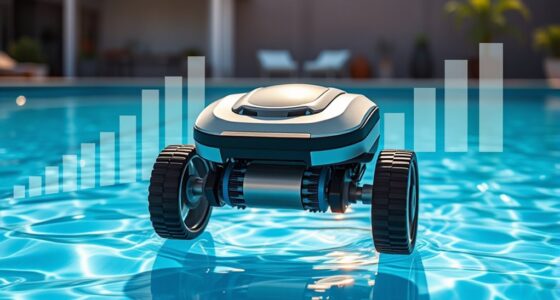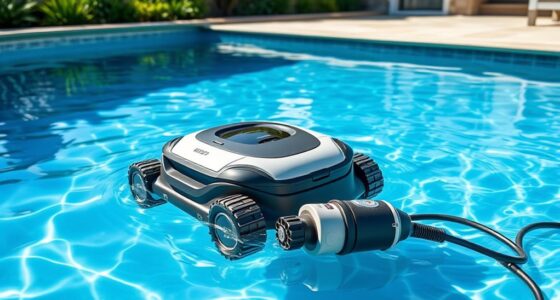To maintain your suction pool cleaner, regularly inspect and clean the filter bag or basket to prevent clogs. Clear debris from intake and nozzles, ensuring water flows freely. Make sure the cleaner’s attachment is secure and properly positioned in the pool. Check hoses and connections for leaks or cracks, replacing parts as needed. Routine care and proper storage help extend the cleaner’s life—continue to learn how to keep it performing at its best.
Key Takeaways
- Regularly inspect and clean the filter bag or basket to prevent clogs and debris buildup.
- Clear debris from intake and nozzles to ensure unobstructed water flow and optimal cleaning.
- Check hose connections for tightness, flexibility, and signs of damage; replace as needed.
- Properly position and secure the cleaner centrally in the pool, avoiding tangles and misalignment.
- Rinse, dry, and store the cleaner in a protected area after each use to prolong its lifespan.
Regularly Inspect and Clean the Filter Bag or Basket
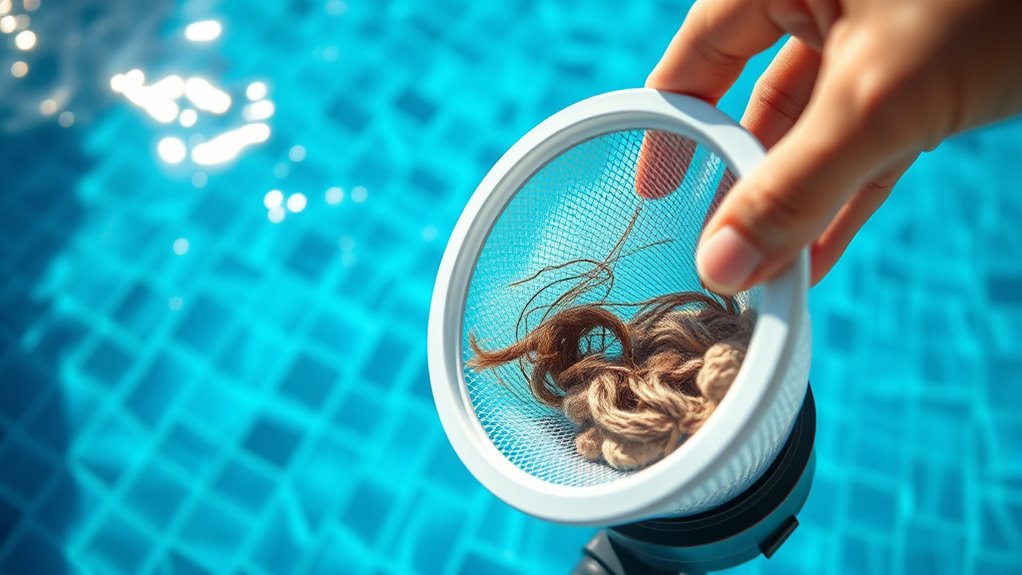
Regularly inspecting and cleaning the filter bag or basket is essential to keep your suction pool cleaner working efficiently. When you do this, you prevent clogs and ensure proper debris removal, maintaining ideal suction power. Check the filter for damage and replace it if it’s torn or excessively worn; fresh filters improve filtration and extend your cleaner’s lifespan. Remove debris like leaves, dirt, and small particles that can block water flow and reduce cleaning effectiveness. Clear out the basket or bag thoroughly, especially after heavy use or storms. Regular filter replacement and debris removal keep your cleaner running smoothly, saving you time and effort in the long run. Incorporating industry trends and cybersecurity measures in your pool equipment can help protect your investment from digital threats. This simple maintenance step helps maintain peak performance and keeps your pool sparkling clean.
Check and Clear the Intake and Nozzles
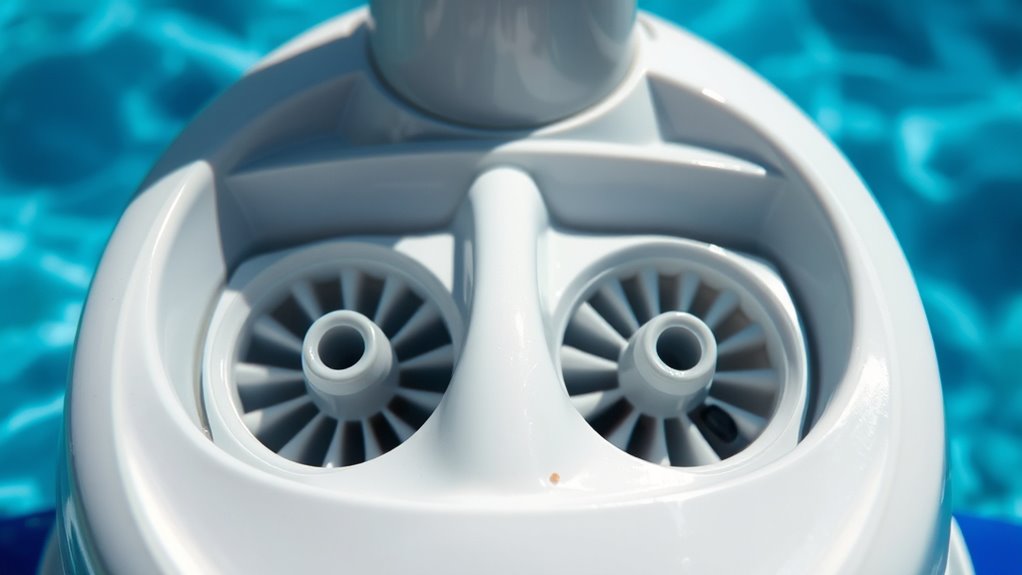
Have you checked the intake and nozzles lately? Regular debris removal keeps your cleaner working efficiently. Inspect the nozzles for any obstructions like leaves, dirt, or hair that can block water flow. Clear these obstructions carefully to restore maximum suction. Also, check the nozzle alignment; misaligned nozzles can reduce cleaning power and leave spots untouched. Gently adjust or reposition them if needed. Make sure the intake is free of debris that might restrict water flow or cause the cleaner to stall. Take a moment to review the contrast ratio, as it plays a role in your pool cleaner’s ability to operate effectively in varying lighting conditions. Proper maintenance of these parts prevents unnecessary wear and prolongs the lifespan of your device. Additionally, examining the filter condition can help ensure optimal water flow and suction strength. Regularly inspecting and cleaning the performance components of your pool cleaner can further enhance its efficiency and durability. For optimal results, consider inspecting the tuning options available for your specific pool cleaner model and adjust as necessary. Being aware of your local resources can also be helpful if you need replacement parts or professional servicing. Taking a few minutes to examine and clean the nozzles and intake ensures your pool cleaner maintains strong suction and effective operation.
Ensure Proper Attachment and Positioning of the Cleaner
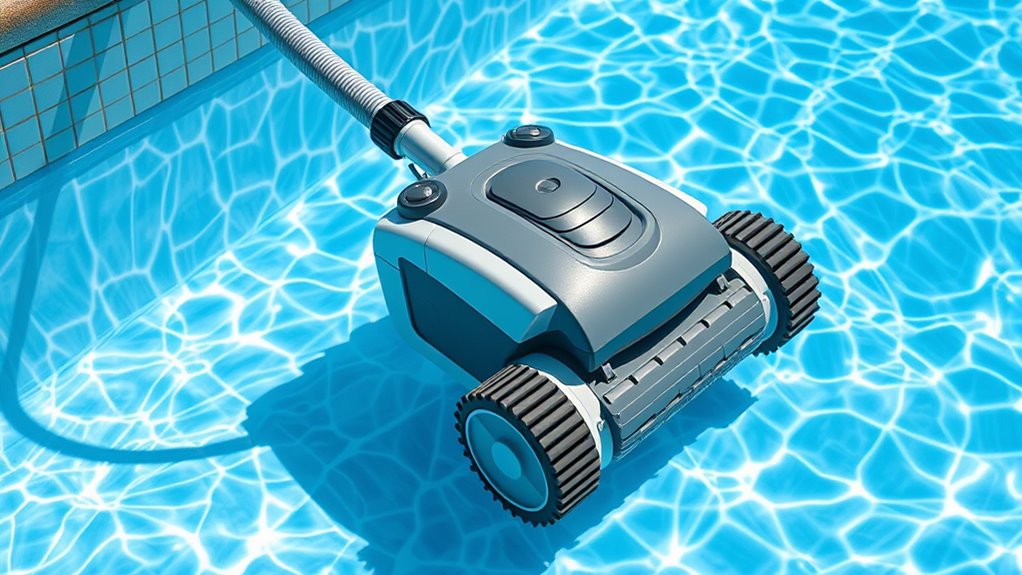
After clearing debris from the nozzles and intake, the next step is to guarantee your cleaner is properly attached and positioned. Proper attachment ensures the cleaner moves smoothly along the pool floor and walls. Check that the hose is securely connected to both the skimmer and the cleaner, with no leaks or loose fittings. Correct positioning involves placing the cleaner in the center of the pool to maximize coverage. Avoid tangles or kinks in the hose that could restrict movement or suction. Make sure the cleaner’s brushes contact the surfaces properly and that it’s not suspended or leaning against the pool walls. Ensuring proper attachment and correct positioning prevents inefficient cleaning and prolongs the lifespan of your suction pool cleaner. Additionally, verifying the electric motor power of your cleaner can help ensure it operates effectively. Regularly inspecting the hose connections can also prevent potential issues and maintain optimal performance. Proper maintenance practices contribute significantly to the cleaner’s efficiency and durability.
Examine and Maintain the Hoses and Connections
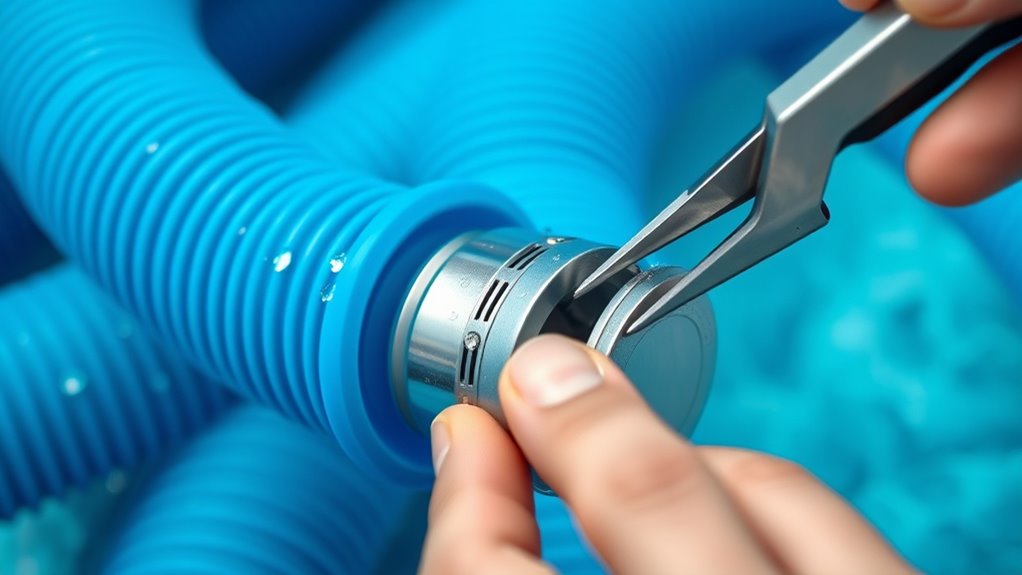
To keep your suction pool cleaner working efficiently, you need to carefully examine and maintain the hoses and connections. Start by checking the hoses for flexibility; stiff or cracked hoses can reduce suction and impair performance. Replace any hoses that have become brittle or show signs of wear. Next, ensure all connections are tight and secure. Loose connections can cause air leaks, decreasing cleaning effectiveness. Firmly attach hoses to the cleaner and ensure the fittings are snug but not over-tightened, which could damage the parts. Regularly inspect for leaks or cracks around the connections, and replace damaged fittings immediately. Maintaining hose flexibility and connection tightness prevents suction loss and keeps your cleaner operating smoothly. Proper upkeep of these components prolongs the lifespan of your cleaner and enhances its cleaning power. Additionally, using durable materials for replacements can help ensure long-term performance and reduce the need for frequent repairs. Paying attention to hose quality can significantly impact the overall efficiency of your pool cleaner. Incorporating regular maintenance routines helps catch issues early and maintains optimal operation. Regularly inspecting connections and fittings ensures that potential leaks are addressed before they affect cleaning performance.
Schedule Routine Maintenance and Storage Practices
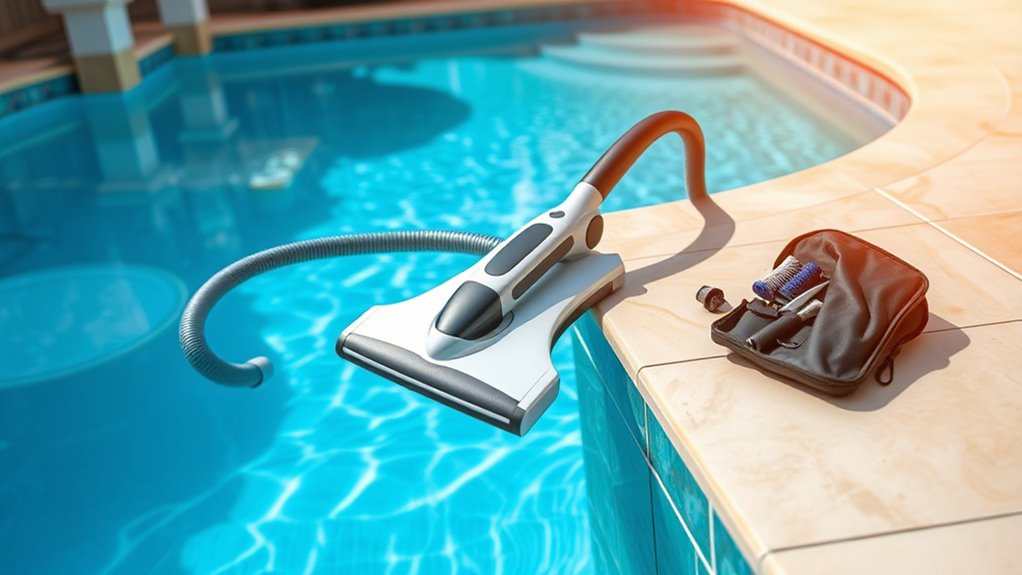
Scheduling routine maintenance and proper storage practices guarantee your suction pool cleaner remains effective and lasts longer. To do this, follow these steps:
- Regularly check and maintain the pool’s chemical balance to prevent buildup and damage.
- Remove the solar cover carefully before cleaning, ensuring debris doesn’t clog your cleaner.
- After each use, rinse the cleaner and store it in a dry, shaded area to prevent corrosion and deterioration. Proper storage also includes protecting the equipment from environmental elements that can accelerate wear.
- Consider inspecting and replacing parts as needed, such as brushes and filters, to ensure optimal performance self-watering plant pots.
- Additionally, regularly inspect the Dad and Daughter Bond to ensure your equipment’s longevity is not affected by neglect or improper handling. Maintaining good equipment care practices can significantly extend the lifespan of your pool cleaner.
- Staying informed about AI in Education developments can help you better understand new features or updates that may improve your maintenance routines over time.
Frequently Asked Questions
How Often Should I Replace the Suction Pool Cleaner’S Parts?
You should replace your suction pool cleaner’s parts based on your maintenance schedule and the condition of the replacement parts. Typically, inspect the brushes, hoses, and seals monthly, and replace them every six months or when signs of wear appear. Regular maintenance helps guarantee peak performance and extends the lifespan of your cleaner. Keep an eye out for leaks, cracks, or reduced suction, which indicate it’s time for replacements.
What Should I Do if the Cleaner Is Not Moving Properly?
If your suction pool cleaner isn’t moving properly, start troubleshooting issues like clogs or obstructions in the hoses and brushes. Check for debris blocking the intake or wheels, and verify the hose connections are secure. Regular maintenance tips include cleaning the filter and inspecting parts for wear. Adjust the float or weights if needed, and make sure the cleaner’s alignment is correct. These steps should help restore smooth operation.
Can I Use Chemicals to Clean the Cleaner’S Components?
You can use chemical cleaning for your suction pool cleaner’s components, but do so carefully. Avoid harsh chemicals that could damage parts; instead, opt for mild solutions like vinegar or specialized pool cleaner products. Regular chemical cleaning helps remove debris and buildup, ensuring proper component maintenance. Always rinse thoroughly after cleaning and check the manufacturer’s instructions to prevent any damage, keeping your cleaner working efficiently.
How Do Temperature Changes Affect the Cleaner’S Performance?
Temperature fluctuations can impact your suction pool cleaner’s performance by affecting how well it moves and seals. When pool water gets too cold or hot, parts may become brittle or expand, reducing efficiency. You might notice slower cleaning or gaps forming. To keep your cleaner working smoothly, monitor water temperature changes and adjust your cleaning schedule accordingly, ensuring it operates effectively despite temperature fluctuations.
Is It Necessary to Calibrate the Cleaner Regularly?
Think of your cleaner as a finely tuned orchestra; without regular calibration, the performance can fall flat. You should calibrate it periodically—every few months—to guarantee peak performance. This calibration frequency helps performance optimization, preventing the cleaner from missing spots or wasting energy. Regular checks keep your cleaner singing in harmony with your pool’s needs, so it works efficiently and keeps your swimming area spotless.
Conclusion
By regularly inspecting and maintaining your suction pool cleaner, you keep it running smoothly and extend its lifespan. Some believe that clean filters and proper nozzle positioning can even improve cleaning efficiency, but studies suggest that consistent maintenance truly prevents clogs and breakdowns. So, stick to your routine, check connections, and store it properly. Your pool will stay sparkling, and your cleaner will perform better, proving that a little upkeep goes a long way.




